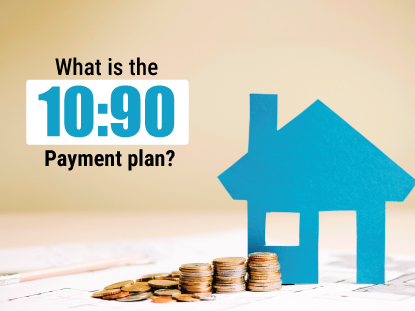Getting home loan is very BASIC now
Get a loan in under 5 mins

Buying a home is one of the most significant investments people make in their lifetime. With various payment plans available, deciding the safest and most beneficial option can sometimes be confusing. One such plan gaining popularity in real estate is the 10:90 payment plan. If you’re new to real estate investing, this guide will help you understand what this plan entails and whether it’s a safe investment.
Table of Contents
The 10:90 payment plan is a real estate financing scheme where a buyer pays 10% of the property’s total cost upfront and the remaining 90% upon project completion. This plan is attractive to buyers who want to minimize initial financial commitment while securing a home at the current market price. Here’s a detailed breakdown of how this plan works:
When you decide to book a property under the 10:90 payment plan, the first step is to make an initial down payment of 10% of the total property value. This payment serves two primary purposes:
The remaining 90 percent home loan is due when the developer completes the construction and offers possession of the property. This is usually at the time when the necessary occupancy certificates have been issued, and the home is ready for you to move in. Here’s how this second phase of payment typically works.
In summary, the 10:90 payment plan offers a clear financial structure, with an easy-to-manage upfront payment followed by a deferred bulk payment upon project completion. This method provides buyers with peace of mind during the construction phase, as they aren’t required to make large financial outlays until the home is ready for possession. However, the plan’s success depends on the developer’s ability to deliver the project on time, which makes it critical to assess the developer’s track record before choosing this payment option.
This plan is often referred to as a builder subvention scheme, as the builder typically bears the financial burden during the construction phase, making it an appealing option for buyers and developers.
While the 10:90 payment plan can seem like a great deal, it’s important to consider its safety and risks. The primary concern is the developer’s ability to complete the project on time. Construction delays can lead to financial stress for both the buyer and the developer.
Before committing to this scheme, it’s essential to:
A more traditional method of paying for a property is the CLP payment plan, which stands for construction linked payment plan. Under the construction-linked plan, payments are made in stages as the construction progresses, typically after certain milestones such as foundation completion, roof construction, and so on. Unlike the 10:90 plan, where most of the payment is deferred until possession, in a CLP plan, the buyer needs to release funds incrementally throughout the construction phase.
This CLP payment plan is often considered safer because payments are tied to the physical progress of the project, reducing the risk of project abandonment. However, it also requires a larger financial commitment upfront, compared to the 10:90 plan, which can be a drawback for buyers with limited immediate funds.
The 10:90 payment plan offers several benefits for both buyers and developers:
While the 10:90 payment plan offers many advantages, it’s crucial to weigh the potential downsides:
The 10:90 payment plan can be an excellent option for homebuyers who want to minimize their initial financial burden and defer most of the costs until possession. However, it’s essential to carefully evaluate the developer’s credibility and the terms of the agreement to ensure you’re making a safe investment.
While the construction linked payment plan (CLP plan) offers more security by linking payments to project progress, the 10:90 plan can provide more immediate affordability. As with any investment, doing your due diligence is crucial to making an informed decision.
Investing in real estate requires careful planning, and the 10:90 payment plan is just one of many options available to buyers today. Make sure it aligns with your financial goals and risk tolerance before taking the plunge.
The 10:90 payment plan is a financing structure where a homebuyer pays 10% of the property cost upfront at the time of booking and the remaining 90% upon completion of the project. This deferred payment plan minimizes the initial financial burden and gives buyers time to arrange the rest of the payment, often through a 90 percent home loan.
The safest real estate investments generally include properties that are completed or near completion, with clear legal documentation, regulatory approvals, and a proven track record of timely delivery from reputable developers. Additionally, investing in construction-linked payment plans (CLP plans), where payments are tied to project milestones, can reduce risk.
The best real estate investment depends on your financial goals, risk tolerance, and market conditions. Ready-to-move-in properties, properties in rapidly developing areas, or homes with financing options like the 10:90 payment plan can be ideal for investors seeking growth and minimal upfront financial commitment.
A 90-10 split in real estate usually refers to a situation where the buyer pays 10% upfront as a booking amount and defers the remaining 90% payment until the property is completed. It could also refer to 90 percent home loans, where the loan covers 90% of the property’s value, and the buyer finances the remaining 10% through personal funds.
Yes, real estate is a strong investment in India, particularly in rapidly growing urban and semi-urban areas. With increasing demand for housing, government initiatives like the Pradhan Mantri Awas Yojana (PMAY), and financing options such as builder subvention schemes or construction-linked payment plans, real estate offers long-term growth potential and wealth accumulation for investors.
Published on 27th September 2024